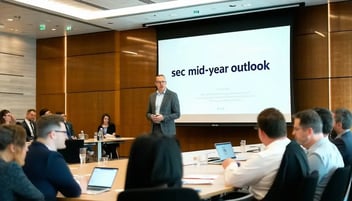
Without the the right processes supported by the right compliance technology, CCO's can spend too much time hunting and gathering information within their organization and not enough time doing the high-level advisory work that adds real value to their firm.
What does it take to develop that clear and holistic view of compliance risk?
Join Mitch Avnet from Compliance Risk Concepts for the on-demand webinar Taking the Broad View: Better Risk and Compliance through Holistic Oversight for practical guidance, including:
MCO’s Know Your Obligations Solution (KYO) offers firms an integrated solution to better understand the relationship between the first line risk management activities of the business and the second line oversight and monitoring of compliance. With KYR, firms can ensure that their compliance oversight process is fit for purpose and minimize the risk of regulatory censure.
Want to learn more? Let us know and one of our experts will be in touch.
In today’s fast-paced global environment, the risks that organizations face are constantly evolving. Therefore, having a strong risk management process in place is a necessity. Failure to adequately prepare for risks will expose your business to major threats further down the line.
Identification
The first step in the risk lifecycle is identification. Ultimately, in order to manage your risks, you need to firstly know what they are. This means that you must begin by identifying the various events that may affect your organization’s ability to achieve its stated objectives and goals. As part of the identification process, you also need to define the risks and assign ownership.
There are a number of risks that exist including financial risks, strategic risks, operational risks and hazard risks. Identifying risks is usually done in a number of ways such as external research, brainstorming sessions, interviews and using previous experience. The main thing to remember is to include as many stakeholders as possible in the process - so that you get the best picture of the whole risk landscape.
Assessment
Having now identified the different risks that exist, the next step is to assess and examine each risk in greater depth. Every individual risk needs to be considered in terms of its likelihood and impact. Some risks only create minor inconveniences, whereas other risks are so severe that they pose a significant threat to the whole business.
As part of the risk assessment process, both qualitative and quantitative assessments are made. All in all, the objective of this step of the lifecycle is to determine which risks need to be prioritised with regards to resources, and how urgent the response needs to be to prevent major negative impact.
Treatment
The third step in the risk lifecycle process is treatment, also commonly referred to as risk management strategy. This is the stage where you devise your strategy to respond to each risk. There are four ways of responding - avoid, transfer, mitigate and accept. Avoid means you eliminate the cause of the threat altogether. Transfer means that you transfer responsibility of the risk to a third party such as an agency. Mitigation involves taking instant steps to reduce the impact of the threat. Finally, acceptance means that you allow for the potential consequences of the risk.
Monitoring and Reporting
It’s crucial that you remember that risk management is a continuous process rather than a linear one. There will always be unknowns, so you must monitor and report on risks on a regular basis.
Firms need to develop a monitoring and reporting strategy that ensures effective communication at all times. This will stop any nasty surprises occurring later down the line. In conclusion, you need to have the proper forums for escalation and be able to action suitable risk responses.
How can MCO help?
Here at MCO, we support clients with managing conduct risk. Conduct risk refers to the activities of multiple individuals from senior executives and staffers to customers, vendors and additional third-party affiliates.
If you would like to learn more about how MCO can assist you in this area, then please contact us today.


